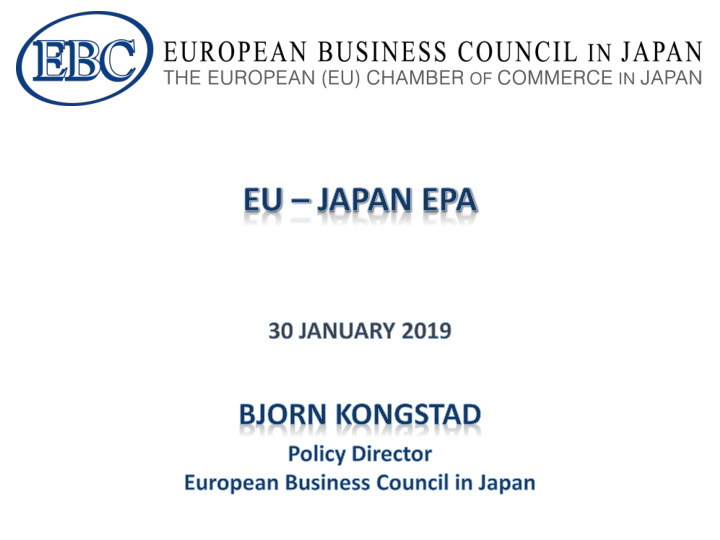



Quick facts about EBC ❑ Established in 1972 as the trade policy arm of the European Chambers of Commerce in Japan ❑ Advocates for an improved business environment for European industry in Japan ❑ EBC is a member organisation where direct members make up the various committees ❑ EBC has currently 24 committees ❑ Most of them are sector committees ❑ A few cross-cutting committees
Key EBC Activities ❑ Hands-on advocacy ❑ Regular meetings with EU and Japanese Government officials & politicians, Keidanren, Tokyo & Osaka Chamber of Commerce, Keizai Doyukai etc ❑ Advocacy on priority issues ❑ Position papers; meet key authorities ❑ Examples: Medical equipments, food additivites etc ❑ White Paper ❑ Issued every November/December, conveys the EBC’s main message to relevant players in the Japanese Government and around the world ❑ Japanese version is sent to every national politician
Historical background ❑ The Regulatory Reform Dialogue ❑ Went on for a number of years without necessarily producing any tangible result ❑ EU – Japan Industrial Policy Dialogue ❑ EU – Japan Customs Cooperation agreement ❑ EU – Japan Summit
EBC asks for an EIA ❑ In 2006/2007 the EBC starts to formulate its request for an Economic Integration Agreement to the EU Commission ❑ The underling theme of the request was to set up an “Internal Market” between EU and Japan ❑ If a product/service has been approved in one market it shall be approved in the other market without the need for additional testing/certification ❑ The Commission was not too keen on the idea and wanted to focus on the EU – Korea FTA negotiations
Preparations for negotiations ❑ At the EU – Japan Summit of May 2011, the two economies decided to start a so called scoping exercise – pre-negotiations ❑ A year later, July 2012, the Commission asked the EU member states for a negotiating mandate, which was given on 29 November 2012 ❑ The first round of negotiations started 15 April 2013
From negotiations to entry into force ❑ After 18 rounds, and a number of intersessions, the two parties on 6 July 2017 announced that the had reached an agreement in principle ❑ Later the same year, 13 December 2017 the negotiations were concluded ❑ Signed 17 July 2018 in Tokyo ❑ After ratification by both the European Paliament and Japanese Parliament in December the EPA will enter into force 1 February 2019
Economic Partnership Agreement ❑ Some 15-16 chapters on tariffs, NTMs, SPS, competition, RoO, services, IPR etc ❑ In terms of trade value, 96.2% of Jaoanese tariffs will be remove EIF ❑ In terms of tariff lines, Japan will remove 96% of tariffs upon EIF ❑ Longest dismantling period: 15 years
Agriculture ❑ Reductions on meat in parity with TPP ❑ Cheese ❑ Hard cheese (gouda, cheddar … ) full liberlisation in 15 years (28.9%) ❑ Soft cheese (brie, feta … ) TRQ ❑ TRQ also for whey, milk powder, condensed milk and butter ❑ For processed food concessions ranges from EIF to 15 years ❑ Pasta 10 yrs ❑ Chocolates and candies 10 yrs ❑ Confectionaries and cookies 5 to 10 yrs ❑ Wines, EIF for both still and sparkling
Agriculture ❑ Fish ❑ Tariff lines currently quotas will be zero duty EIF ❑ Blue fin tuna will be eliminated over 5 yrs ❑ Geographical Indications (GIs) ❑ Irish Cream ❑ Irish Whisky/Whiskey and Uisce Beatha Eireannach ❑ Completely excluded from the agreement are rice, sea weed and whales ❑ Irish export in agriculture is mainly meat, dairy and fish
Industrial goods ❑ Forestry products, some EIF, a majority 7 yrs and some 10 yrs ❑ Full liberalisation in sectors such as chemical, plastics, cosmetics, metal, textile and clothing ❑ Shoes ❑ 21% or 24.6% EIF, rest to be dismantled over 10/15 yrs ❑ Ski boots over 10 yrs ❑ Irish export for industrial goods: chemicals, pharma and medical devices. Possibly cosmetics too.
Rules of Origin ❑ Products have to have EU or Japan origin to benefit from the EPA ❑ Wholly obtained ❑ Substantial transformation taking place inside EU or Japan ❑ Change in tariff classification ❑ Value added ❑ Product-specific rules ❑ Statement of Origin by the exporter ❑ Origin declaration document made our by importer ❑ May require additional explanatory sheet
Non-tariff measures (NTM/NTB) ❑ The EU Commission spent considerable effort on this chapter and this was also where the EBC was most involved. ❑ A big portion is allocated to automobiles -> an annex ❑ Food additives – timelines will be introduced for the approvals ❑ Timber ❑ Pharmaceuticals – expansion of GMP ❑ Beef ban ❑ Wash instruction symbols
Public procurement ❑ Single point of access for publication of notices ❑ Expansion of covered cities, 19 -> 49 cities ❑ Removal of the operation safety clause ❑ Maximum one year transition period ❑ An element of reciprocity
Geographic Indications (GIs) ❑ Japan will recognise about 200 EU GIs (both food and drinks) without the need to go through the domestic GI registration process ❑ Some GIs might be in used by third countries ❑ Trademarks might become invalid ❑ GIs and trademarks might also be used in parallel
Recommend
More recommend